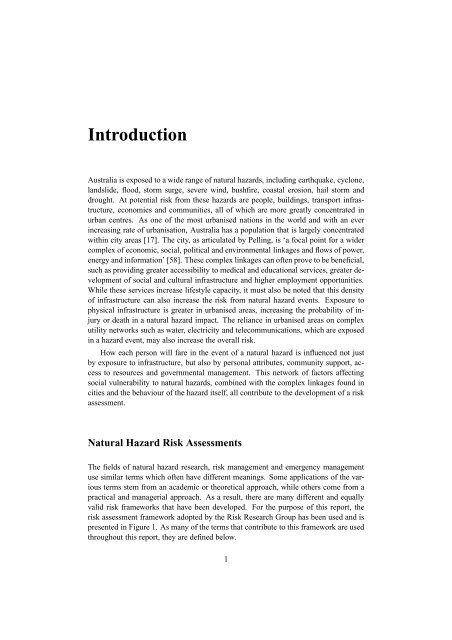Quantifying Social Vulnerability: A methodology for ... - EarthByte
Quantifying Social Vulnerability: A methodology for ... - EarthByte
Quantifying Social Vulnerability: A methodology for ... - EarthByte
You also want an ePaper? Increase the reach of your titles
YUMPU automatically turns print PDFs into web optimized ePapers that Google loves.
IntroductionAustralia is exposed to a wide range of natural hazards, including earthquake, cyclone,landslide, flood, storm surge, severe wind, bushfire, coastal erosion, hail storm anddrought. At potential risk from these hazards are people, buildings, transport infrastructure,economies and communities, all of which are more greatly concentrated inurban centres. As one of the most urbanised nations in the world and with an everincreasing rate of urbanisation, Australia has a population that is largely concentratedwithin city areas [17]. The city, as articulated by Pelling, is ‘a focal point <strong>for</strong> a widercomplex of economic, social, political and environmental linkages and flows of power,energy and in<strong>for</strong>mation’ [58]. These complex linkages can often prove to be beneficial,such as providing greater accessibility to medical and educational services, greater developmentof social and cultural infrastructure and higher employment opportunities.While these services increase lifestyle capacity, it must also be noted that this densityof infrastructure can also increase the risk from natural hazard events. Exposure tophysical infrastructure is greater in urbanised areas, increasing the probability of injuryor death in a natural hazard impact. The reliance in urbanised areas on complexutility networks such as water, electricity and telecommunications, which are exposedin a hazard event, may also increase the overall risk.How each person will fare in the event of a natural hazard is influenced not justby exposure to infrastructure, but also by personal attributes, community support, accessto resources and governmental management. This network of factors affectingsocial vulnerability to natural hazards, combined with the complex linkages found incities and the behaviour of the hazard itself, all contribute to the development of a riskassessment.Natural Hazard Risk AssessmentsThe fields of natural hazard research, risk management and emergency managementuse similar terms which often have different meanings. Some applications of the variousterms stem from an academic or theoretical approach, while others come from apractical and managerial approach. As a result, there are many different and equallyvalid risk frameworks that have been developed. For the purpose of this report, therisk assessment framework adopted by the Risk Research Group has been used and ispresented in Figure 1. As many of the terms that contribute to this framework are usedthroughout this report, they are defined below.1
















